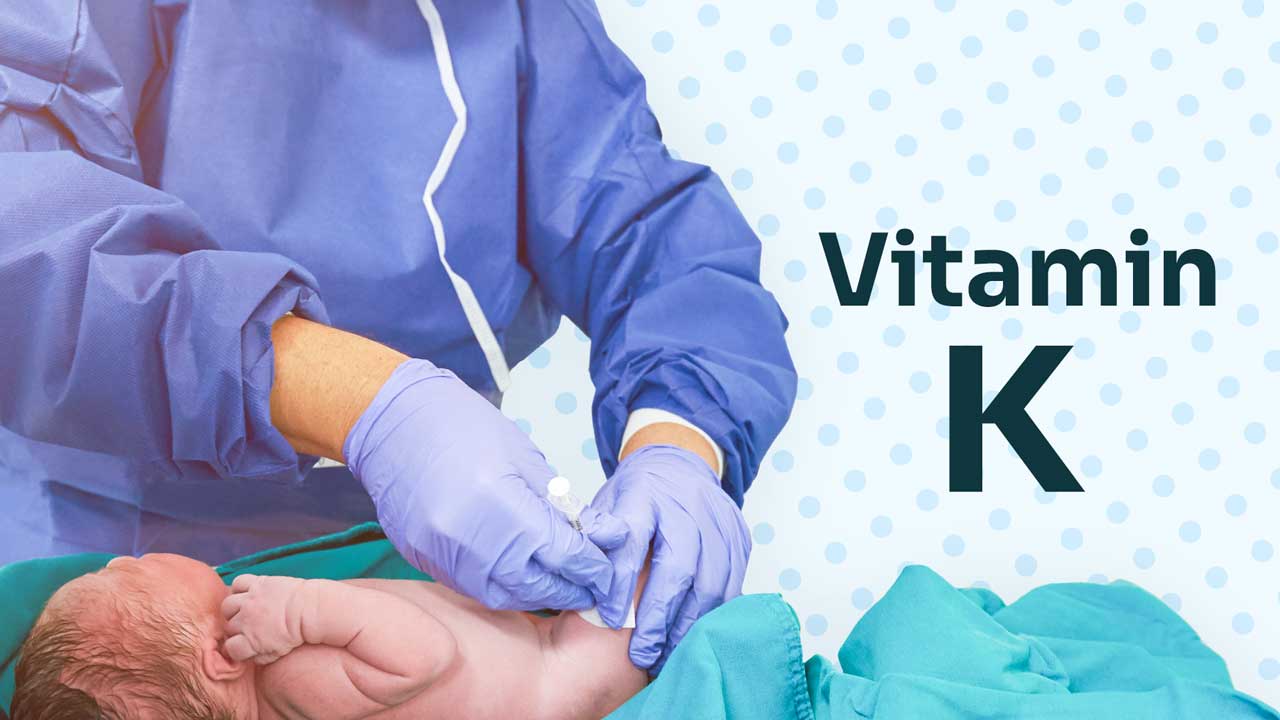Vitamin K is an important component in the clotting cascade. Without it, newborn infants are at greater risk of haemorrhagic disease, with potentially fatal consequences. This is why all newborn babies are offered prophylactic Vitamin K in the immediate period after birth as a routine therapeutic intervention (Gold Coast Health 2023).
Vitamin K Deficiency Bleeding
Vitamin K deficiency bleeding (VKDB), previously known as haemorrhagic disease of the newborn (HDNB), was first identified over a century ago. It describes bleeding in the newborn that is not due to traumatic birth or haemophilia. Caused by vitamin K deficiency due to insufficient prenatal storage of vitamin K, combined with insufficient vitamin K in breast milk, HDNB presents as unexpected bleeding, often with gastrointestinal haemorrhage, ecchymosis and intracranial haemorrhage (Ng & Loewy 2018; Nimavat 2019).
All newborn babies have inadequate reserves of Vitamin K at birth. This is partly because Vitamin K1 does not cross the placenta easily, resulting in low fetal plasma concentrations, and partly because vitamin K is found in relatively low concentrations in breast milk, making breastfed babies particularly vulnerable to VKDB (Gold Coast Health 2023; Eden et al. 2023).
Three Types of Vitamin K Deficiency
There are three types of VKDB that have been identified, each classified according to when symptoms first appear:
- Earl VKDB occurs within the first 24 hours of birth and is often associated with maternal medications that inhibit vitamin K activity, such as antiepileptic medications.
- Classic VKDB occurs between days 1 to 7 and is associated with a low intake of vitamin K.
- Late VKDB usually presents between 2 and 12 weeks of age but may occur up to 6 months after birth. It is associated with chronic malabsorption and low vitamin K intake. This occurs almost exclusively in breastfed babies.
(Gold Coast Health 2023; Nimavat 2019; Eden et al. 2023)
Vitamin K Prophylaxis

As Ng and Loewy (2018) report, vitamin K prophylaxis has been well-researched and shown to effectively reduce vitamin K deficiency bleeding of any severity in the first week of life.
A single intramuscular injection of vitamin K at birth can effectively prevent VKDB and is recommended for all newborn infants (Gold Coast Health 2023).
If oral prophylaxis is used, it should be administered in three doses:
- At birth
- At three to five days old
- At four weeks old.
(Gold Coast Health 2023)
Note that oral prophylaxis is less effective than a vitamin K injection. Other disadvantages of oral administration include the baby spitting out the dose of vitamin K or vomiting within the first hour of administration (Eden et al. 2023).
In Australia, it’s recommended that:
- All newborn infants should receive vitamin K prophylaxis.
- Healthy newborn infants should receive vitamin K either:
- By intramuscular injection of 1 mg (0.1 mL) at birth, or
- As three 2 mg (0.2 mL) oral doses given at birth, at the time of newborn screening between three to five days of age and again in the fourth week.
(NHMRC et al. 2010)
This final dose is not required in babies who are predominantly formula-fed, as milk formulas naturally contain vitamin K supplementation. It’s also important that the third dose is given no later than four weeks after birth, as the effect of earlier doses is known to decrease after this time (NHMRC et al. 2010).
Vitamin K Prophylaxis for Preterm Infants
For preterm babies, the situation is slightly different as they are at even greater risk of vitamin K deficiency bleeding due to hepatic immaturity and delayed gut colonisation with microflora (Ng & Loewy 2018).
Preterm infants may require a smaller dose of vitamin K (Pregnancy Birth & Baby 2022). They should only receive vitamin K via injection. Oral prophylaxis is not suitable for preterm infants as they are more likely to have feeding difficulties, and a smaller dose may be difficult to measure by mouth (NHMRC 2012).
Managing Parental Refusal
Mihatsch et al. (2016) note that parents who receive prenatal education about the importance of vitamin K prophylaxis are far more likely to comply with administration after birth. The nurses and midwives who administer vitamin K also have a key role to play in educating and reassuring parents (Holley et al. 2020).
That said, according to Hamrick et al. (2016), the most common source of information for parents is the internet, with over 70% of parents saying they are influenced by online information. Common concerns frequently mentioned by parents include fears about:
- Synthetic or toxic ingredients
- Excessive dose
- Side effects.
Loyal et al. (2019) has explored the reasons behind parental reluctance to allow vitamin K administration and discovered the following four major themes:
- Risk-to-benefit ratio, where parents refuse intramuscular vitamin K due to a perceived risk to their newborn from preservatives.
- ‘Natural’ approaches, which lead to seeking oral vitamin K or increasing the mother's own prenatal dietary vitamin K intake.
- Placement of trust and mistrust, which involves mistrust of the medical and pharmaceutical community with overlapping concerns about vaccines.
- Reflections on prior hospital visits and poor communication with health care providers.

Therefore, it’s recommended that:
- During the antenatal period, parents should be provided with written information explaining the importance of vitamin K prophylaxis and the options available (intramusuclar or oral).
- Informed consent procedures should be followed.
- There should be a system in place to ensure the decision made about prophylaxis method is still valid and appropriately communicated to the staff involved in childbirth and the postnatal period.
(NHMRC et al. 2010)
Topics
References
- Eden, RE, Daley, SF & Coviello, M 2023, ‘Vitamin K Deficiency’, StatPearls, viewed 30 January 2024, https://www.ncbi.nlm.nih.gov/books/NBK536983/
- Gold Coast Health 2023, Vitamin K Injection for Newborns, Queensland Government, viewed 30 January 2024, https://www.goldcoast.health.qld.gov.au/our-services/vitamin-k-injection-newborns
- Hamrick, H et al. 2015, 'Reasons for Refusal of Newborn Vitamin K Prophylaxis: Implications for Management and Education', Hospital Pediatrics, vol. 6, no. 1, viewed 2 February 2024, https://hosppeds.aappublications.org/content/6/1/15.short
- Holley, S et al. 2020, 'Educating Parents on Vitamin K Prophylaxis for Newborns', Nursing for Women's Health, vol. 24, no. 4, viewed 30 January 2024, https://www.sciencedirect.com/science/article/abs/pii/S1751485120300994
- Loyal, J et al. 2019, 'Refusal of Vitamin K by Parents of Newborns: A Qualitative Study', Academic Pediatrics, vol. 19, no. 7, viewed 2 February 2024, https://www.sciencedirect.com/science/article/abs/pii/S1876285919301135
- National Health and Medical Research Council 2012, Vitamin K for Newborn Babies, Australian Government, viewed 30 January 2024, https://www.nhmrc.gov.au/sites/default/files/documents/attachments/vitamin-k-english.pdf
- National Health and Medical Research Council, Paediatric Division of the Royal Australasian College of Physicians, Royal Australian and New Zealand College of Obstetrics and Gynaecology, Royal Australian College of General Practitioners & Australian College of Midwives 2010, Joint Statement and Recommendations on Vitamin K Administration to Newborn Infants to Prevent Vitamin K Deficiency Bleeding in Infancy, Australian Government, viewed 30 January 2024, https://ranzcog.edu.au/wp-content/uploads/2022/05/Vitamin-K-Administration-to-Newborn-Infants-to-Prevent-Vitamin-K-Deficiency-Bleeding-in-Infancy.pdf
- Mihatsch, W et al. 2016, 'Prevention of Vitamin K Deficiency Bleeding in Newborn Infants', Journal of Pediatric Gastroenterology & Nutrition, vol. 63, no. 1, viewed 30 January 2024, https://journals.lww.com/jpgn/FullText/2016/07000/Prevention_of_Vitamin_K_Deficiency_Bleeding_in.26.aspx
- Ng, E & Loewy, AD 2018, ‘Guidelines for Vitamin K Prophylaxis in Newborns’, Paediatrics & Child Health, vol. 23, no. 6, viewed 30 January 2024, https://academic.oup.com/pch/article/23/6/394/5075070?login=false
- Nimavat, DJ 2019, Vitamin K Deficiency Bleeding, Medscape, viewed 30 January 2024, https://emedicine.medscape.com/article/974489-overview
- Pregnancy Birth & Baby 2022, Vitamin K at Birth, Healthdirect, viewed 30 January 2024, https://www.pregnancybirthbaby.org.au/vitamin-k-at-birth
 New
New 
